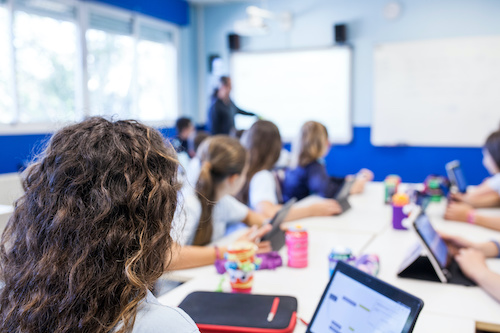Key points:
- Technology is a great tool–but what specific tech aids in student learning?
- Discover some of the best technologies that improve student learning
- Stay up-to-date on all things concerning learning in the digital age
In the modern educational landscape, technology plays a pivotal role in shaping how students are learning in the digital age. From interactive apps to online platforms, edtech tools cater to diverse learning styles and enhance educational experiences. Let’s examine the transformative impact of specific technologies that empower students, fostering engagement, personalization, and skill development in the dynamic realm of learning.
What technology helps students learn?
Various types of technology play a crucial role in enhancing students’ learning experiences. Examples of technologies that improve student learning include adaptive learning platforms like Khan Academy, offering personalized instruction. Educational apps such as Duolingo engage students with interactive language learning. Virtual reality applications like Google Expeditions provide immersive experiences. Coding programs such as Scratch foster critical thinking and problem-solving. Online collaboration tools like Padlet encourage teamwork and discussion. Digital textbooks offer interactive content, and assistive technologies like speech-to-text tools support diverse learning needs, collectively creating a dynamic and enriched learning environment for students.
How does technology help students learn?
Technology profoundly benefits students’ learning experiences by offering versatile tools that cater to diverse needs and learning styles. Educational apps and interactive software engage students, making learning enjoyable and accessible. Adaptive learning platforms tailor instruction to individual progress, addressing specific strengths and weaknesses, and fostering a personalized learning journey.
Technology promotes active engagement through interactive elements, such as gamified learning platforms, multimedia content, and virtual simulations. This captivates students’ attention, encouraging them to actively participate in the learning process.
Online collaboration tools facilitate communication and teamwork–vital skills in the digital age. Virtual reality applications offer immersive experiences, making abstract concepts tangible and enhancing experiential learning.
Technology cultivates digital literacy, critical for navigating the modern world. Coding programs and robotics kits introduce hands-on learning, promoting critical thinking and problem-solving skills essential for the future.
Technology provides instant feedback through online assessments, allowing students to track their progress and make timely adjustments. The integration of assistive technologies supports diverse learning needs, ensuring inclusivity.
In essence, technology transforms the learning landscape by creating dynamic, interactive, and personalized educational experiences—and underscoring the importance of technology in the classroom. By fostering engagement, critical thinking, and collaboration, technology prepares students for the challenges of the digital era, equipping them with essential skills for lifelong success.
What are 5 benefits of technology?
The integration of technology brings about numerous benefits–including the benefits of technology for students–across various aspects of daily life.
1. Technology enhances communication, facilitating instant global connectivity through platforms like social media and messaging apps. This interconnectedness fosters collaboration and information sharing.
2. Technology streamlines efficiency and productivity. Automation and digital tools in the workplace optimize processes, saving time and resources. This includes technologies like project management software and communication platforms.
3. Technology contributes to education by providing access to vast information and interactive learning resources. Educational apps, online courses, and virtual tools cater to diverse learning styles, democratizing access to knowledge.
4. Technology enhances healthcare through innovations like telemedicine, wearable devices, and electronic health records. These advancements improve patient care, enable remote monitoring, and streamline medical data management.
5. Technology enhances entertainment and leisure. Streaming services, virtual reality experiences, and online gaming offer diverse and immersive entertainment options, catering to individual preferences.
In summary, technology enriches communication, efficiency, education, healthcare, and entertainment, significantly impacting various aspects of contemporary life and contributing to the advancement and interconnectedness of society.
What is the most used technology in the classroom?
Among technology tools for teaching and learning, one of the most prevalent and widely-used technologies in today’s classrooms is the computer or laptop. These devices have become indispensable tools for both educators and students, facilitating a range of educational activities.
Computers enable access to vast online resources, educational software, and collaborative platforms, enhancing research, communication, and information sharing. They support interactive lessons, multimedia presentations, and digital assessments, fostering a dynamic and engaging learning environment. With the integration of computing devices, classrooms have evolved into digitally enriched spaces, promoting digital literacy and preparing students for the demands of the 21st century.
The versatility of computers makes them a cornerstone technology, empowering educators to deliver diverse and impactful lessons while equipping students with essential skills for the modern world.
Conclusion
The array of technologies transforming education today offers myriad benefits, enhancing the learning journey for students. From interactive apps to collaborative platforms and adaptive learning tools, technology fosters engagement, personalization, and critical skill development. These advancements go beyond traditional methods, creating dynamic and inclusive learning environments that cater to diverse needs.
As technology continues to evolve, its positive impact on education is evident, preparing students for the challenges of the future and shaping a more accessible, engaging, and future-ready educational landscape. Embracing these technologies ensures a holistic and enriched learning experience for students at all levels.
- Classroom Learning - April 5, 2024
- Advantages and Disadvantages of Classroom Management - April 5, 2024
- What are Disadvantages of Classroom Management? - April 5, 2024

